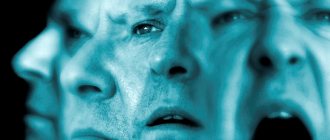The Salvation Clinic treats psychotic disorders using innovative techniques and classical approaches, offers effective strategies for the prevention of mental illnesses, including schizophrenia, proper care to reduce the suffering of patients, and social support. We have a specialized hospital, good technical and personnel potential. We provide assistance with hospitalization.
Symptoms of psychotic disorder
Symptoms are varied, individual in nature, and may change over time. Main signs: delusions and hallucinations. The latter represent extraordinary sensory sensations that are incomparable with reality. For example:
- vision of images, paintings;
- hearing voices;
- sensation of touch;
- sensation of smells, tastes.
Hallucinations can be tactile, auditory, olfactory, visual, or somatic. An image appears in thinking without an external stimulus. A person can be in a world of dreams and unfulfilled fantasies. A deceptive perception of reality can be observed when:
- severe fatigue;
- taking psychoactive substances;
- neurological diseases;
- schizophrenia.
This mental disorder is also characterized by delusional ideas. A person insists on his point of view, despite the fact that there is clear evidence and logical explanations for his wrongness. The patient may feel as if someone is constantly following him. These could be the intelligence services of various states, as well as mythical creatures and aliens. In other cases, the patient feels that his husband/wife is constantly cheating on him. Some patients may experience delusions of grandeur. They are simply convinced that they are able to perform various miracles, that they are prophets. Others consider themselves descendants of a noble family. Delusion can also manifest itself in relation to one’s sexuality. It seems to the patient that all strangers fall in love with him at first sight. Unrealistic ideas may appear due to:
- infection with an incurable disease;
- the imminent end of the world;
- creation of a perpetual motion machine;
- carrying out ridiculous social reforms;
- parasite infestation.
You should also consult a doctor if you notice the following symptoms:
- slurred speech;
- illogical thinking;
- inappropriate behavior;
- indifference to appearance;
- excessive irritability;
- tendency to harm one's health;
- lack of plans for the future;
- inhibition of actions and thoughts;
- apathy towards everything that happens;
- depressive moods.
Relatives can call a doctor to your home. Don't wait for the situation to get worse. It is possible to change the life of a loved one for the better. Don't be afraid to tell a specialist about your problem. We are ready to listen right now, provide confidentiality, and provide effective assistance.
Pathogenesis
As a result of psychotrauma, inhibition occurs in the cerebral cortex and its subcortical structures.
The specific clinical form of psychosis depends on the spread of inhibition. In acute and prolonged psychoses, the main pathogenetic factor is the pathodynamic structures responsible for the extent of inhibition in the cerebral cortex. In this case, the main neuroassociative stream is involved in a given point of the cortex and remains fixed there. This is the mechanism of one of the main symptoms of reactive states - the pathological fixation of patients’ attention on traumatic thoughts. In psychogenic stupor, inhibition from the pathodynamic structure is concentrated in the motor (cortical and subcortical) parts of the brain, when, for example, in hysterical psychoses (with impaired consciousness) pathological excitation appears in them.
The experiences of patients with reactive psychoses depend on the functional ability of the pathodynamic structure itself. When it is fixed in pathological arousal, patients are reliably fixed on psychotraumatic circumstances; and vice versa, in the presence of phase states, patients experience psychotrauma in a positive way for themselves, as is observed in some psychogenic twilight states and delusional fantasies.
When the pathodynamic structure transitions into an inhibitory state, patients “forget” everything that is directly or indirectly associated with psychotrauma and even the fact of its presence (the mechanism of affectogenic amnesia in delusional fantasies, pseudodementia, puerilism, etc.).
Reactive paranoid syndrome, in the cerebral cortex, causes a number of isolated from each other, but associated with the pathodynamic structure of the diseased points in the cerebral cortex, which determines the psychogenic content of their specific delusional ideas in these patients. In subacute paranoid reactive psychoses and in cases of psychogenic delusional psychosis, in the cerebral cortex there is a functionally isolated single powerful pathodynamic neuroassociative structure in a state of inert excitation, switching over the main neuroassociative flow.
The differences in the clinical picture and further course of the disease are determined by the fact that the paranoid reaction is formed under the influence of acute psychotrauma on the basis of any phenotype of the nervous system, while in psychogenic paranoid delusions the pathodynamic structure is formed under conditions of chronic psychotraumatization on the basis of an initially inert phenotype of the nervous system - paranoid psychopathy.
Psychotic levels of disorder
There are a large number of mental disorders that are reflected differently in the behavior and thinking of the patient. Common features of the disorders: inappropriate behavior, inability to socialize. The most common mental illnesses are: depression, schizophrenia, dementia, mental retardation, autism, anxiety, obsessive-compulsive disorder, and phobias.
Acute psychotic disorder
In this situation, the patient's condition deteriorates very quickly. Signs of nervous system imbalance appear within 3-14 days. Symptoms: strong euphoria or, on the contrary, detachment from the outside world, delusional ideas, various hallucinations. Symptoms are constantly changing. It is assumed that the causative factors of the disease are severe stress:
- loss of loved ones;
- car accident;
- loss of a favorite job;
- traumatic brain injuries;
- mental and physical violence;
- postpartum depression.
Drug use and excessive alcohol consumption can also trigger the disorder. Symptoms can be eliminated within a few weeks with drug therapy. They use drugs that stimulate brain activity and increase stress resistance: vitamins, neurometabolic stimulants, drugs that promote the restoration of liver cells, new generation neuroleptics. However, it is important to attend a consultation with a psychotherapist so that central nervous system failure does not lead to the development of schizophrenia. The dosage of medications is reduced gradually. In the acute phase, the support of loved ones is important. A psychologist can also work with them. This is the only way to eliminate the risk of relapse.
Polymorphic psychotic disorder
Characterized by rapid development (hallucinations, delusions, depression, euphoria appear within 14 days). Symptoms change and are quickly relieved with the help of special medications. The exact causes of mental disorder are unknown. It has been reliably established that the onset of the disease is preceded by severe stress. Acute polymorphic psychotic disorders are confirmed in 0.4-0.6% of cases. If symptoms do not disappear within several months, the patient is given a different diagnosis.
Organic psychotic disorder
Deviations arise as a result of disturbances in brain structures. This could be a traumatic brain injury, circulatory disorders, infection, autoimmune disease, oxygen starvation of brain cells.
Psychotic affective disorders
The appearance of depressive moods is characteristic. A person loses the ability to enjoy life, withdraws into himself, and shows indifference to everything that happens around him. Other manifestations of depression:
- low self-esteem;
- pessimistic perception of reality;
- impaired concentration;
- disturbance of sleep and wakefulness;
- refusal to eat;
- suicidal tendencies;
- inappropriate feeling of guilt.
Transient psychotic disorder
In severe cases of the disease, inhibition of action and thinking and loss of mood are observed. Depression in psychotic affective disorder can be replaced by a joyful mood, excessive physical activity, increased activity, and overexcitement.
Reasons for the development of the disease
Examining patients undergoing treatment in a hospital, doctors came to the conclusion that most often acute psychosis is a consequence of:
- mental illnesses, such as bipolar disorder or schizophrenia;
- prolonged complete or partial lack of sleep;
- somatic disorders;
- use of certain medications;
- taking drugs, high doses of alcohol.
Doctors classify into separate groups OPD that occurs:
- After childbirth. The disorder is called postpartum. It is associated with a complex of causal factors: complications that arose during childbirth, the mental characteristics of the woman, overwork, and hormonal imbalances.
- After the death of a loved one (psychogenic form). It is a strong emotional reaction to the loss of a significant relative or friend.
Acute polymorphic psychotic disorder with symptoms of schizophrenia
Psychotic and affective symptoms are stable. There are no sudden changes in behavior or mood. The onset of the disease is within two weeks after the occurrence of the provoking factor. Symptoms are typical for schizophrenia:
- depressive moods;
- echo of thoughts;
- expression of inappropriate emotions;
- various kinds of hallucinations;
- persecution mania.
To diagnose this disorder, it is important to conduct a thorough examination of the patient. It is necessary to exclude the fact of schizophrenia, schizoaffective psychosis or bipolar disorder, the presence of traumatic brain injuries, the influence of toxic, psychoactive substances on the body. The following diagnostic methods are mandatory:
- general blood analysis;
- electroencephalography;
- interviewing the patient;
- survey of relatives;
- Neurotest;
- Neurophysiological test system.
Diagnosis of psychosis
Psychotic illnesses are such that a long period of time can pass between their onset and the discovery of clearly expressed symptoms. However, in later stages, psychosis is much more difficult to treat, so it simply needs to be diagnosed at the very beginning, when the disease has not yet begun to develop. To do this, you should pay attention to symptoms that are uncharacteristic of the disease: frequent headaches, increased irritability, unstable mood, impaired cognitive functions of the brain. If a person exhibits the previously described symptoms, then the best decision would be to consult a psychiatrist. Only a specialist will be able to identify the disease and exclude the likelihood of developing psychosis and the disorders that accompany it.
Methods for diagnosing psychosis include:
- genetic analysis;
- assessment of family history;
- filling out specialized questionnaires and scales that are designed to identify deviations from normal behavior.
Researching your family history is important because mental illness can sometimes run in families.
It is also possible to use some instrumental diagnostic methods - MRI and CT. With their help, it will be possible to exclude the presence of other diseases (for example, tumors) that are accompanied by similar symptoms.
Management of patients after discharge
After discharge, the patient undergoes outpatient treatment, which includes observation, drug therapy and psychotherapy. Outpatient treatment is necessary to monitor the effectiveness of drug therapy during the period of gradual reduction in drug dosage.
Outpatient treatment continues for 1 year. The patient visits the attending physician once every 2–3 weeks. In the presence of concomitant mental disorders that have caused the onset of APPD, regular visits to a psychotherapist are a prerequisite for recovery.
Our psychotherapists and psychologists with extensive clinical experience provide sessions of individual, group and relaxation psychotherapy. Depending on the case, the doctor will select the method and the required number of sessions. As a rule, psychotherapy sessions are held at intervals of 2–3 weeks. At the patient's request, sessions can be held more frequently.








